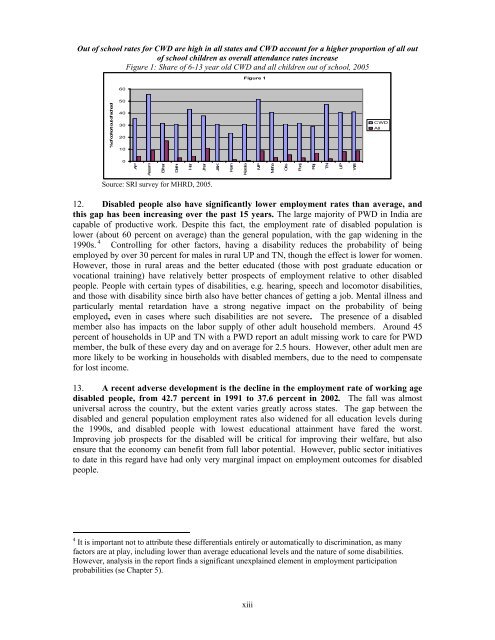People with Disabilities in India: From Commitment to Outcomes
People with Disabilities in India: From Commitment to Outcomes
People with Disabilities in India: From Commitment to Outcomes
You also want an ePaper? Increase the reach of your titles
YUMPU automatically turns print PDFs into web optimized ePapers that Google loves.
Out of school rates for CWD are high <strong>in</strong> all states and CWD account for a higher proportion of all out<br />
of school children as overall attendance rates <strong>in</strong>crease<br />
Figure 1: Share of 6-13 year old CWD and all children out of school, 2005<br />
Figure 1<br />
60<br />
%of cohort out of school<br />
50<br />
40<br />
30<br />
20<br />
10<br />
CWD<br />
All<br />
0<br />
AP<br />
Assam<br />
Bihar<br />
Delhi<br />
Har<br />
Jhar<br />
J&K<br />
Karn<br />
Kerala<br />
MP<br />
Maha<br />
Oris<br />
Punj<br />
Raj<br />
TN<br />
UP<br />
WB<br />
Source: SRI survey for MHRD, 2005.<br />
12. Disabled people also have significantly lower employment rates than average, and<br />
this gap has been <strong>in</strong>creas<strong>in</strong>g over the past 15 years. The large majority of PWD <strong>in</strong> <strong>India</strong> are<br />
capable of productive work. Despite this fact, the employment rate of disabled population is<br />
lower (about 60 percent on average) than the general population, <strong>with</strong> the gap widen<strong>in</strong>g <strong>in</strong> the<br />
1990s. 4 Controll<strong>in</strong>g for other fac<strong>to</strong>rs, hav<strong>in</strong>g a disability reduces the probability of be<strong>in</strong>g<br />
employed by over 30 percent for males <strong>in</strong> rural UP and TN, though the effect is lower for women.<br />
However, those <strong>in</strong> rural areas and the better educated (those <strong>with</strong> post graduate education or<br />
vocational tra<strong>in</strong><strong>in</strong>g) have relatively better prospects of employment relative <strong>to</strong> other disabled<br />
people. <strong>People</strong> <strong>with</strong> certa<strong>in</strong> types of disabilities, e.g. hear<strong>in</strong>g, speech and locomo<strong>to</strong>r disabilities,<br />
and those <strong>with</strong> disability s<strong>in</strong>ce birth also have better chances of gett<strong>in</strong>g a job. Mental illness and<br />
particularly mental retardation have a strong negative impact on the probability of be<strong>in</strong>g<br />
employed, even <strong>in</strong> cases where such disabilities are not severe. The presence of a disabled<br />
member also has impacts on the labor supply of other adult household members. Around 45<br />
percent of households <strong>in</strong> UP and TN <strong>with</strong> a PWD report an adult miss<strong>in</strong>g work <strong>to</strong> care for PWD<br />
member, the bulk of these every day and on average for 2.5 hours. However, other adult men are<br />
more likely <strong>to</strong> be work<strong>in</strong>g <strong>in</strong> households <strong>with</strong> disabled members, due <strong>to</strong> the need <strong>to</strong> compensate<br />
for lost <strong>in</strong>come.<br />
13. A recent adverse development is the decl<strong>in</strong>e <strong>in</strong> the employment rate of work<strong>in</strong>g age<br />
disabled people, from 42.7 percent <strong>in</strong> 1991 <strong>to</strong> 37.6 percent <strong>in</strong> 2002. The fall was almost<br />
universal across the country, but the extent varies greatly across states. The gap between the<br />
disabled and general population employment rates also widened for all education levels dur<strong>in</strong>g<br />
the 1990s, and disabled people <strong>with</strong> lowest educational atta<strong>in</strong>ment have fared the worst.<br />
Improv<strong>in</strong>g job prospects for the disabled will be critical for improv<strong>in</strong>g their welfare, but also<br />
ensure that the economy can benefit from full labor potential. However, public sec<strong>to</strong>r <strong>in</strong>itiatives<br />
<strong>to</strong> date <strong>in</strong> this regard have had only very marg<strong>in</strong>al impact on employment outcomes for disabled<br />
people.<br />
4 It is important not <strong>to</strong> attribute these differentials entirely or au<strong>to</strong>matically <strong>to</strong> discrim<strong>in</strong>ation, as many<br />
fac<strong>to</strong>rs are at play, <strong>in</strong>clud<strong>in</strong>g lower than average educational levels and the nature of some disabilities.<br />
However, analysis <strong>in</strong> the report f<strong>in</strong>ds a significant unexpla<strong>in</strong>ed element <strong>in</strong> employment participation<br />
probabilities (se Chapter 5).<br />
xiii










